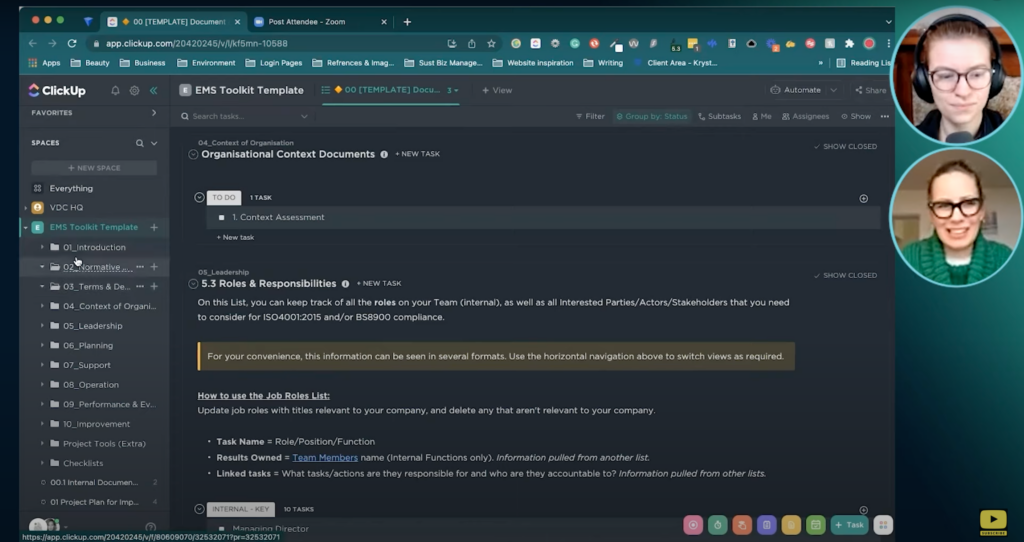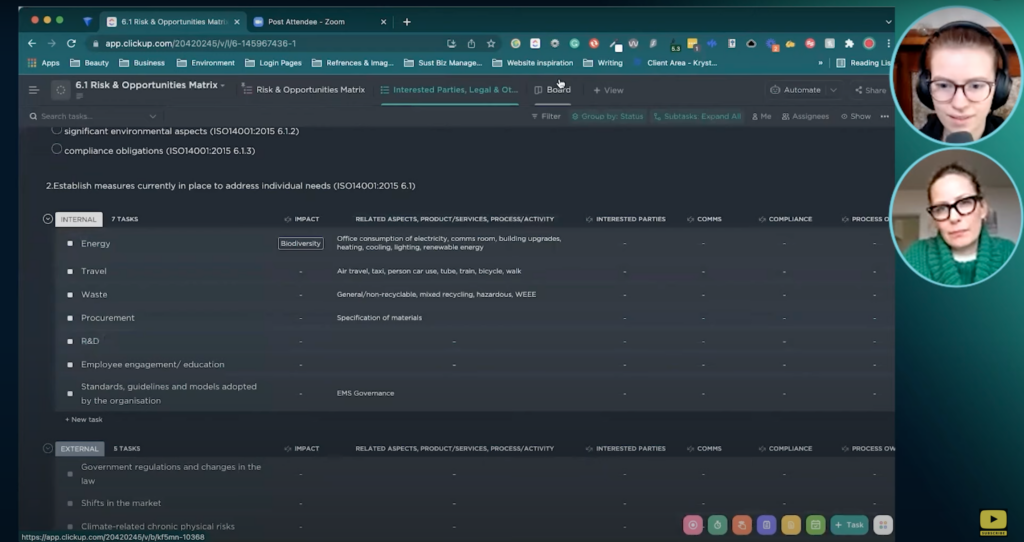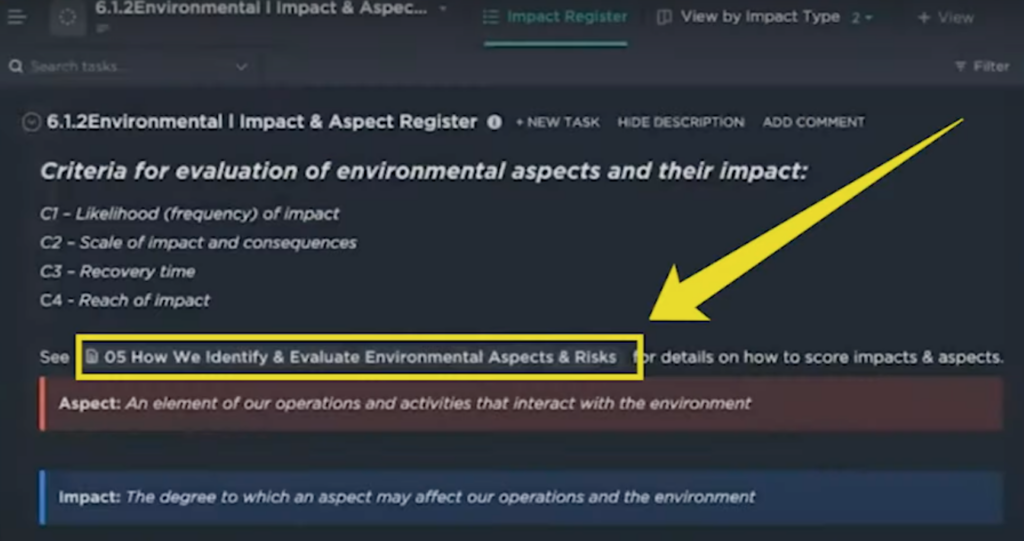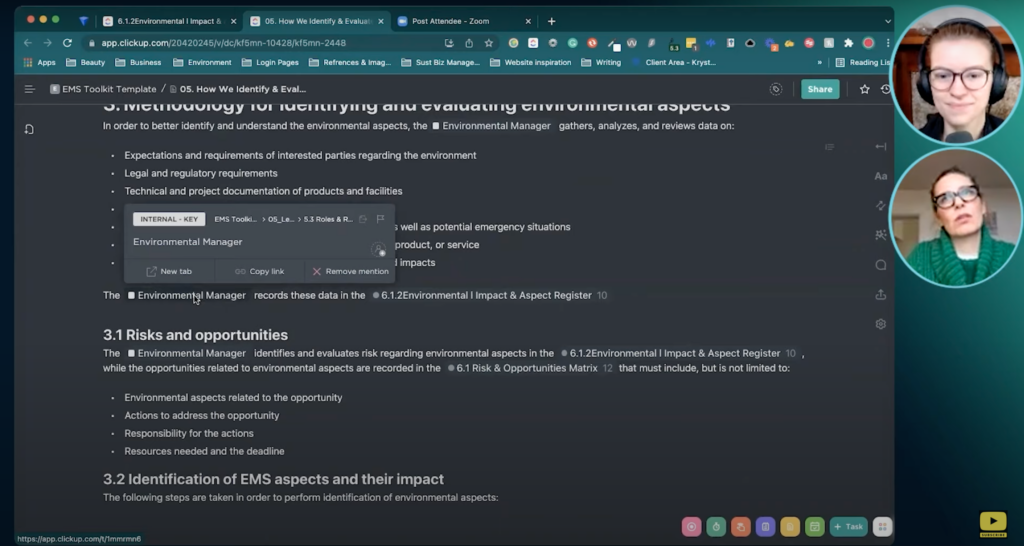Looking to use ClickUp with consulting clients? We’ve got a special sneak peek just for you! 😉
In this interview, Khandiz (a member of the ProcessDriven Membership) is going to take us behind the scenes on how she’s streamlined her process with her consulting clients using ClickUp — and how she learns more and more about her field of work along the way.
About our Guest
Khandiz is a hybrid professional. She likes to call herself a Creative Sustainableist.
As an accomplished international artist and qualified sustainability professional, she works with both businesses and individuals to transform their vision into one that stimulates social, environmental, and economic cohesion. She strives to design creative solutions which are ‘conducive to happiness’ and have a positive impact on all Life. Talk about important work!
Khandiz is going to show us around her ClickUp account and provide more details as to how she has everything organized. We’re only going to be showing you just a clip of the full interview that we featured inside the ProcessDriven Membership for our members. We also have a live Q&A in there if you are a member watching this. However, for the purposes of this clip today, I want to give you some backstory. First of all, let’s have Khandiz introduce herself!
Khandiz: I’ve recently transitioned from being a hair and makeup artist for 20 years to being a sustainability consultant. I use ClickUp to manage my clients’ projects because it’s very iterative — it really uses templates and processes beautifully. I also do sustainable website design and run my own business. So, I’ve separated my ClickUp into that structure. Today, we’re going to look at how I’ve taken the Process Driven Membership and built out a very complex management system as a template, so I can keep using the same processes for my clients.
Okay, so that’s the perspective we’re going to be looking at now inside the ClickUp account. The clip I want to highlight for you here is how Khandiz is using Docs. She’s using Docs and List Information to add some structure and instruction to her consulting client engagements. Anyone who is a coach, consultant, or works with clients in any way who are either in your ClickUp or see your ClickUp, could benefit from stealing some of this knowledge.
So with that, let me flip over to the interview where Khandiz is going to tell us how exactly she’s managing her ISO certification clients inside ClickUp by using ClickUp Docs and List Information.
Work with consulting clients inside ClickUp? This clip is for you!

Khandiz: I built this out as a template because I will need to recreate this entire Folder template for every client that is going for this particular kind of certification. This is my Space. These are all of the items that we need; one to ten are required. Then, within each of these Folders, some of them contain more information. Some of them have documents that I’ve set up as templates for each of my clients, for example, and they can just go in and update their own details once we’ve added it as a template.
Layla: So for you, if I’m understanding correctly and just to clarify this, the hardest part of ClickUp for most people is that hierarchy.
Want to learn more about the ClickUp Hierarchy? Check out this intro to the ClickUp Structure blog here.
But, you’ve taken this directly from the certification structure requirements and that’s what you’re going to do. What I like about this, is that they’re not all the same. It’s not like every number one and number five all have the same structure. Each one is broken out differently. Is that kind of how this is?
Khandiz: Yes, that’s exactly how this is. For instance, this deck of Docs, they’re going to be the same for every client. They need to be there. They have to have an example of what it is. So, I’ve been able to just build out this template. It’s really nice and easy to duplicate.
Adding Relationships to really up the ante

But, when we go to something like “Planning,” which is a big part of your environmental management system, this is where things get really interesting.
I can break it down to internal and external items that need to be managed, what their impact is. I’ve created another list and we’ve got a nice relationship list. The impacts will be on biodiversity. These are the aspects we need to think about. I’ve just used a nice little typing option here.
Layla: This is just so great.
Khandiz: So this has taken something I’ve definitely learned from the course and built it out even better in line with the standard requirements that I need to build it out. So we can break it down into interested parties, board view, if people prefer. So, again, depending on who’s managing it from the client side — if it’s me or if I need other players to come in and have a look — we’ve got those different views because obviously, as we all know, ClickUp can be completely overwhelming.
Layla: No. What?
Khandiz: So lots of lists, lots of stuff that pulls through in multiple places. This is another very big example of custom fields to pull through that I can then show all the different types of impact and keep a record. This is a requirement, but I’ve made it nicer in ClickUp!
Want to learn more about the ClickUp Custom Fields? Check out this intro to the ClickUp Custom Fields blog here.
Layla: This is probably the prettiest ISO reporting I’ve ever seen.
Using mentions to tag Tasks inside ClickUp Docs

I just want to pop in here with a moment of explanation. You see those little highlighted squares that show the name of a list or a task inside her setup? This is a mention that is being used inside the document. This is the ‘@@’ or ‘@@@’ symbol that is tagging other tasks or other docs so everything is interconnected.
Alright, back to the interview.
Engaging your consulting clients: How much access do they need in clickup?
Layla: Now tell me, just so I understand how this gets applied. You have all of these different areas, and I hope we’ll still walk through a few more of them. How exactly is the client being engaged in this? Is this something that you’re monitoring and maintaining? Is this something you’re installing? What does that look like?
Khandiz: It really depends on the client. I work predominantly with micro and SMEs, but the reality is most people don’t have a management system in place. They don’t have any kind of system. We are having to see this massive shift of reducing emissions, on saving energy, on saving money, on moving towards sustainable businesses and sustainability in its truest context. But there’s no management system in place. So what I’m trying to do for my clients, what my offering is, is make things conducive to happiness. How do we make really complex, boring things that we have to do to save the planet and save ourselves as a species and a civilization? How do we make it a little bit more fun and engaging? So, some clients I’m going to get to move to ClickUp and I will take them through this process so they can carry on on their own. And others, I will be operating as their Environmental Manager and will be overseeing this, and just giving them guest access.
Layla: It’s interesting when we have really complex structures like this. You actually don’t have that many automations because the complexity is actually in the structure you’ve built out. I think that’s a pretty interesting difference with other structures — where you see one task — but then there’s 18 automations because it tends to be a trade off.
Khandiz: Right. Yeah. I think it’s funny because I’ve not seen many other systems. I’ve only had this really small introduction to ClickUp and processes. And I think what for me was so valuable — and I think I’ve said this to you before — is processes are something that’s never been properly explained. And for the work that I do, it is critical. Those SOPs, those things are coming in, and I’m able to take that and totally build it into this management system.
Layla: Well, I see a piece of that in your list information section where I see there’s some kind of doc embedded in there. So, it sounds like you’re also using this, not just for SOPs, but also education. I mean, still kind of an SOP, but client education seems to be somehow blended into this. Is that correct?
Khandiz: That’s correct. So, part of this environmental management system is you have a whole series of procedures. Literally that is what it is. They’ve got the procedures. I’m not even writing the SOPs. I’m just updating them.
Using the ClickUp building process to build knowledge in your industry

This will then take us through to the guided procedure for the standard. So, this is the template that they would need. We can fill out the information here. That then links to the register straight away. So, I can click that and it’s going to take us to the impact register directly. I’ve linked it as much as possible. I’ve also linked our roles list.
Obviously with templates and ClickUp, I’m going to have to redo all the relationships. So, that’s one thing I realized is going to become a problem. But what I’ve found really interesting in building this out since I am new to this system, it’s really allowed me to learn the system that I need to do for compliance, which I found really helpful.
Layla: At a certain point, you just have it memorized.
Khandiz: You do. You do memorize it. You go: “Oh! Okay, that’s how that links up.” And I’ve taken the 14,001 system and actually expanded it beyond that to other management systems. But we’ll go into that another day.
Isn’t that amazing? Now, this is just one clip of the tour, but trust me when I say Khandiz has built out a really cool system in ClickUp that’s going to help herself and her consulting clients organize all of the parts involved in the ISO certification process. It’s become so valuable for her own business that she’s turned around and started to sell it to other businesses in her space.
Actually, let me just have her tell you.
Khandiz: In building out that big system and really getting comfortable with ClickUp, I think that’s the important thing. Not only am I able to offer a really good client service, I have an entirely new revenue stream and a very niche opportunity as a ClickUp consultant. I’m not interested in building out a full management system, but I’ve already got my first client: another sustainability consultant. So, I can build out a whole ClickUp for them. Again, if we’re talking about true sustainability, I’ve literally got another revenue stream to keep me going. Even if I’m not doing consulting to a client, I now have this as an option.
Talk about sustainability.
Want to see the rest of this amazing ClickUp tour? Check it out inside the ProcessDriven Membership here.
Enjoy the process!
